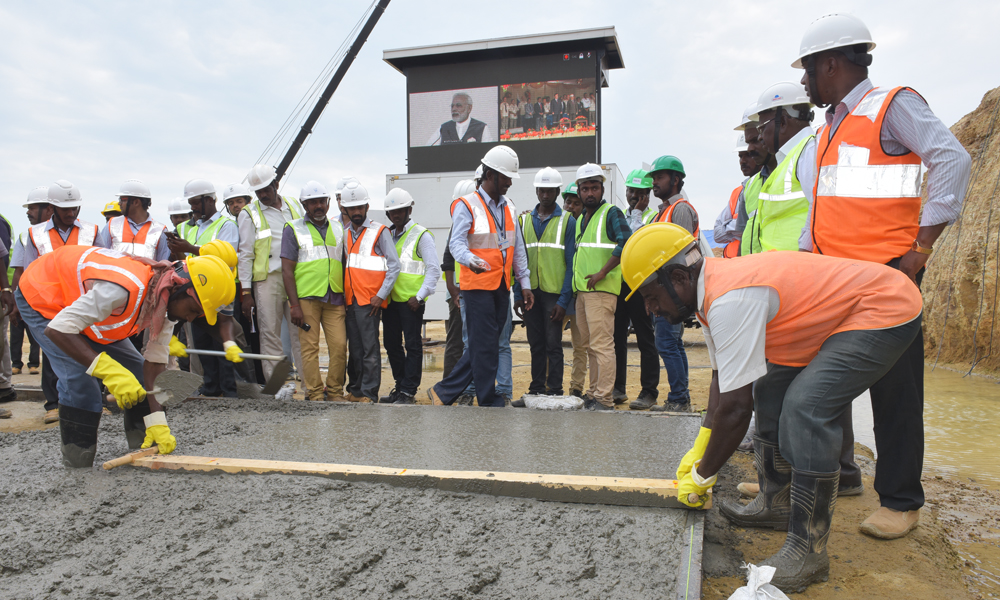
Kudankulam Second Phase Got Underway
back to contentsThe two national leaders watched the first concrete pouring ceremony that was video conferenced from the site of Kudankulam Units 3 and 4 during the BRICS summit in Goa. Valery Limarenko, CEO of ASE Group, commented on the event. “We are handing over the second unit of the Indian nuclear station to our partners. Obligations we assumed were ambitious, and we have fulfilled them in a joint effort with our Indian partners. The Russian-Indian team did an excellent job. Guided by unconditional principles of safety and efficiency, we keep working. And I do hope we will always stay one step ahead”, Valery Limarenko said during the video conference.
“The handover of Kudankulam Unit 2 and laying of the foundation for Units 3 and 4 are tangible results of the civil nuclear cooperation between our countries,” said Narendra Modi.
In January 2016, the Indian nuclear regulator issued a construction permit for Unit 3 and 4. The construction is now ongoing, with excavation works in progress and office premises erected. ASE Group has begun shipments of design documents, equipment and materials.
The Kudankulam nuclear station is constructed in the Indian state of Tamil Nadu in accordance with the bilateral agreement of 20 November 1988 and an addendum of 21 June 1998.
The Kudankulam project’s second phase was designed by AtomEnergoProekt and includes two VVER-1000 reactors. The design fully complies with the current regulatory and technical documents of the Russian Federation and the IAEA. It has also been certified as compliant with the European Utility Requirements (EUR).
The project’s general contractor is ASE Group responsible for detailed design, equipment supplies and technical support. AtomEnergoProekt acts as a general designer. The project owner is Nuclear Power Corporation of India Limited (NPCIL).
According to Vladimir Putin, Russia will stay committed to its obligations and provide extensive support for its Indian partners in the nuclear power field. “We are drafting a framework agreement for Unit 5 and Unit 6 of the Kudankulam nuclear station. The plan for the next 20 years is to construct at least 12 Russian-design nuclear reactors,” Vladimir Putin said. He noted that Kudankulam would add much to the Indian energy security by providing the local community and production facilities with a reliable source of power and giving a new impetus to the national economic development.
Rosatom’s CEO Alexei Likhachov noted that civil nuclear cooperation between Russia and India resulted in the most prominent and ambitious project. According to Rosatom’s CEO, the Indian party is very much satisfied with the performance of Kudankulam Unit 1, and the two countries plan to continue their partnership and construct 12 more power units on other sites within the next 20 years. As soon as Unit 2 begins commercial operation, which is expected in 2017, India’s aggregate nuclear generation capacity will reach almost 7 GW.
In the meantime, a framework agreement for the construction of Kudankulam Units 5 and 6 and a loan agreement have been agreed upon between the parties and are expected to be signed by the end of 2016. Russia has undertaken to provide a $3.4bn loan for the project’s second phase (Units 3 and 4), or 85% of the price of construction contracts signed with Russian suppliers. The Indian authorities are working hard to allocate a new site for the construction of Russian-designed Units 5 and 6 as soon as possible. Russia is India’s key partner in the development of its national nuclear generation industry. Electric power to be generated by the Kudankulam nuclear station is vital for Southern India comprising the states of Tamil Nadu, Kerala, Karnataka and the Union Territory of Puducherry. Besides, the joint nuclear program contributes to the Indian mechanical engineering industry through an extensive involvement of local contractors. Reactor vessels and heavy equipment for Units 3 and 4 have been ordered already. Just as before, heavy equipment for the reactor islands will be supplied by Russian manufacturers. However, many other components will be designed and manufactured by Indian companies.




